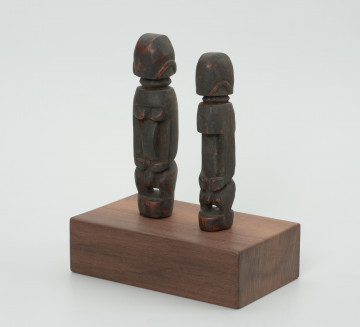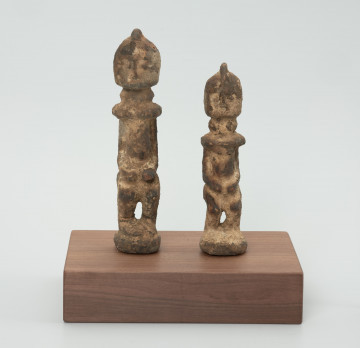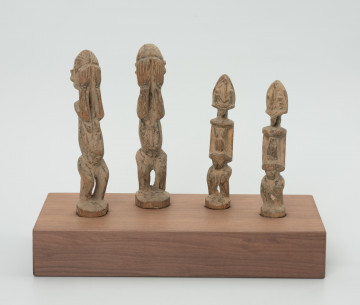
Divination set
między 1951 — 2000
National Museum in Szczecin
Part of the collection: Collection of Dogonian art
The divination set consists of eight figures - seven anthropomorphic and one zoomorphic. Most of them were made schematically. No facial features were marked on the rather large heads. All of them were covered with a layer of white sacrificial substance, most probably millet pulp. The figure of the hornbill (calao), a symbol of motherhood, is fascinating. The beak of the bird and the swollen belly refer to the double-male and female - procreative power and signify pregnancy. The calao sculpture is rarely found in fortune-telling sets.Among the figures of human figures, two have their hands raised. The gesture is one of the more common motifs found in representations of Dogon ancestors. It is interpreted as a prayer, a call for the union of heaven and earth. A sign of the alliance of these worlds is the rain, which is particularly precious in the agricultural country of the Dogon. According to Dogon mythology, the rains divide the first Nommo - Nommo Die. The Nommo are among the essential entities in the Dogon religion. They are four pairs of twins created as the first beings, just after Earth, Heaven and Water by Amma, the creator god, also considered water deities. Nommo Die remains in heaven alongside Amma, of whom he is the governor. He reveals himself through thunderstorms, lightning, and a rainbow called the Nommo way. When the rainy season is delayed, or there is a drought, farmers request a fortune-teller who, on their behalf, asks Yurugu - the mythical pale fox (Vulpes pallidus), a deity who, according to Dogon mythology, has acquired the gift of clairvoyance of when to sow grain. Sowing grain too early or postponing the first rain could cause crop failure and famine. Priests from Aru were also endowed with the power of summoning rain. According to myth, a man from Aru first begged the god for the rain to fall on the earth. That is why, to this day, it is believed that only hogon (priests) of Aru can help in times of drought.
Katarzyna Findlik-Gawron
Author / creator
Dimensions
cały obiekt: height: 19,2 cm, width: 32 cm
Object type
sculpture
Creation time / dating
Creation / finding place
Identification number
Location / status

między 1951 — 2000
National Museum in Szczecin

między 1951 — 2000
National Museum in Szczecin

między 1951 — 2000
National Museum in Szczecin
DISCOVER this TOPIC
Castle Museum in Łańcut
DISCOVER this PATH
Educational path